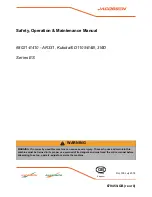
Operation
•
Be alert, slow down and use caution when
making turns. Look behind and to the side
before changing directions.
•
Do not operate the engine in a confined space
where dangerous carbon monoxide fumes can
collect.
•
Mow only in daylight or in good artificial light.
•
Before attempting to start the engine,
disengage all blade attachment clutches and
shift into neutral.
•
Do not use on slopes greater than 15 degrees.
•
Remember there is no such thing as a safe
slope. Travel on grass slopes requires particular
care. To guard against overturning:
– do not stop or start suddenly when on a
slope;
– use slow speeds on slopes and during tight
turns;
– stay alert for humps and hollows and other
hidden hazards;
•
Use care when pulling loads or using heavy
equipment.
– Use only approved drawbar hitch points.
– Limit loads to those you can safely control.
– Do not turn sharply. Use care when
reversing.
•
Watch out for traffic when crossing or near
roadways.
•
Stop the blades rotating before crossing
surfaces other than grass.
•
When using any attachments, never direct
discharge of material toward bystanders
nor allow anyone near the machine while in
operation.
•
Never operate the machine with damaged
guards or without safety protective devices in
place.
•
Do not change the engine governor settings or
overspeed the engine. Operating the engine
at excessive speed can increase the hazard of
personal injury.
•
Before leaving the operator’s position:
– disengage the power take-off and lower the
attachments;
– change into neutral and set the parking
brake;
– stop the engine and remove the key.
•
Disengage drive to attachments, stop the
engine, and disconnect the spark plug wire(s)
or remove the ignition key
– before clearing blockages or unclogging
chute;
– before checking, cleaning or working on
the lawnmower;
– after striking a foreign object. Inspect
the lawnmower for damage and make
repairs before restarting and operating the
equipment; if the machine starts to vibrate
abnormally (check immediately).
•
Disengage drive to attachments when
transporting or not in use.
•
Stop the engine and disengage drive to
attachment
– before refuelling;
– before removing the grass catcher;
– before making height adjustment unless
adjustment can be made from the operator’s
position.
•
Reduce the throttle setting during engine
run-out and, if the engine is provided with
a shut-off valve, turn the fuel off at the
conclusion of mowing.
Maintenance and Storage
•
Keep all nuts, bolts and screws tight to be sure
the equipment is in safe working condition.
•
Never store the equipment with fuel in the
tank inside a building where fumes can reach
an open flame or spark.
•
Allow the engine to cool before storing in any
enclosure.
•
To reduce the fire hazard, keep the engine,
silencer, battery compartment and fuel storage
area free of grass, leaves, or excessive grease.
•
Check the grass catcher frequently for wear or
deterioration.
•
Replace worn or damaged parts for safety.
•
If the fuel tank has to be drained, this should
be done outdoors.
5
Summary of Contents for Z334 Z-Master
Page 8: ...Slope Chart 8 ...
Page 44: ...Figure 53 1 Keep the end of the bolt ush with the nut 3 Nut 2 Rear pivot bracket 4 Bolt 44 ...
Page 54: ......
Page 55: ......






































